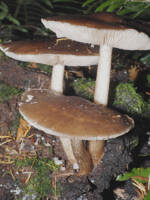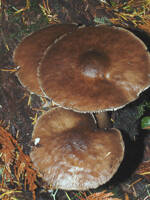Distribution: Grows on a variety of woody substrates, including sawdust and wood chips, and can be found throughout the year when temperature and moisture are conducive. It often is one of the early spring species at lower elevations.
Conservation Status: Not of concern
P. cervinus usually is medium-sized but can become larger and more robust. It has a smooth, satiny, brownish to blackish brown, umbonate cap that is often darkest in the center. The flesh is white and has a strong odor of radish or potato. The gills are close, white then pinkish, and the edges are white-fringed (use a handlens). The stipe is cylindrical, slightly enlarged at the base, fibrous, and white with grayish black fibrils. P. atromarginatus (Konrad) Kühner is very similar to P. cervinus, but has dark gill edges and seems to occur only on conifer wood. Care should be taken not to confuse pluteuses with similar entolomas, many of the latter being extremely poisonous.
PNW Herbaria: Specimen records of Pluteus cervinus in the Consortium of Pacific Northwest Herbaria database
CalPhotos: Pluteus cervinus photos




















